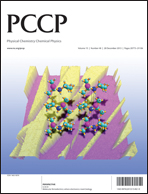Self-assembly of a set of hydrophilic–solvophobic–hydrophobic coil–rod–coil molecules based on perylene diimide†
Abstract
The self-assembly and the resulting morphology of a set of asymmetrically substituted perylene diimide is discussed. We synthesized perylene diimides with hydrophilic Jeffamine® (PEO/PPO co-oligomer) attached to the imide nitrogen on one side and (hydrophobic) alkyl chains of different lengths on the other. Although studies on asymmetrically substituted perylene diimides have been reported by various authors, both side chains in this work are linear and we discuss the effect of the length of the hydrophobic alkyl side chain on the self-assembly in water and aqueous mixtures and the resulting morphology. We find that self-assembly occurs in water in a range of concentrations (from 10−7 to 10−4 M), and the mode of packing of the H-stacked molecules changes with concentration for the propyl substitution. Although self-assembly does not occur in non-aqueous solvents such as acetone, it does upon addition of water. While other authors observed nano-belts and nano-fibers with asymmetrically substituted perylene diimides, the morphology of drop-cast films in our work consists of folded sheets and hollow tubes, of a few microns in diameter. Such folding in a non-chiral system such as the present case is attributed to predominant asymmetry of interactions between the molecules in the three directions, as we discussed in our previous work on an hydrogen bonded system (S. Khanna, M. K. Khan and P. Sundararajan, Langmuir, 2009, 25, 13183–13193).


 Please wait while we load your content...
Please wait while we load your content...